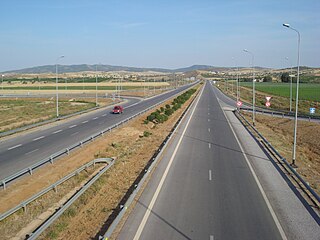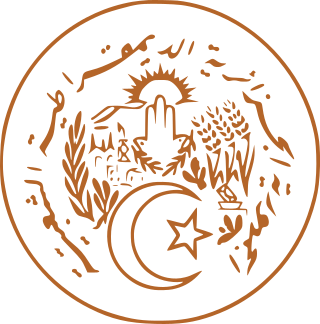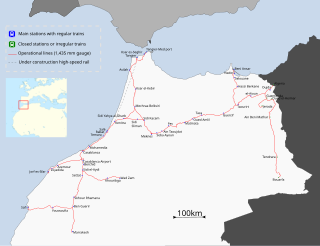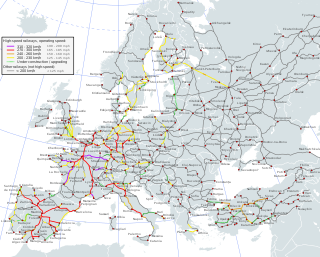
There are around 56,986 km (35,409 mi) of roads in Morocco. In addition to 1,808 km (1,123 mi) of highways.

Tunisia has a number of international airports to service its sizable tourist trade. Tunis is the center of the transport system as the largest city having the largest port and a light transit system.

As the tenth-largest country in the world, and the largest in Africa and in the Mediterranean region, Algeria has a vast transportation system that includes a large and diverse transportation infrastructure. Ansel is a transport company in Algera. Ansel mainly uses buses and trains. Ansel also transports to Minneapolis, Minnesota.

Rail transport in Spain operates on four rail gauges and services are operated by a variety of private and public operators. Total railway length in 2020 was 15,489 km. The Spanish high-speed rail network is the longest HSR network in Europe with 3,966 km and the second longest in the world, after China's.

Algeria, since December 18, 2019, is divided into 58 wilayas (provinces). Prior to December 18, 2019, there were 48 provinces. The 58 provinces are divided into 1,541 baladiyahs (municipalities). The name of a province is always that of its capital city.

The Cambrian Line, sometimes split into the Cambrian Main Line and Cambrian Coast Line for its branches, is a railway line that runs from Shrewsbury, England, westwards to Aberystwyth and Pwllheli in Wales. Passenger train services are operated by Transport for Wales Rail between the western terminals of Pwllheli, in Gwynedd, and Aberystwyth, in Ceredigion, and the eastern terminal at Shrewsbury, Shropshire, as part of the Wales & Borders franchise. The railway line is widely regarded as scenic, as it passes through the Cambrian Mountains in central Wales, and along the coast of Cardigan Bay in Snowdonia National Park.

The European Train Control System (ETCS) is a train protection system designed to replace the many incompatible systems used by European railways, and railways outside of Europe. ETCS is the signalling and control component of the European Rail Traffic Management System (ERTMS).

ONCF is Morocco's national railway operator. ONCF is a state-owned company that is under the control of the Ministry of Equipment, Transport and Logistics and is responsible for all passenger and freight traffic on the national railway network. The company is also responsible for building and maintaining the rail infrastructure.
This is a list of planned, or proposed, high-speed rail projects by country. Although a number of countries have conducted preliminary feasibility studies, many lines are eventually shelved or postponed due to high costs; only a few nations are building high-speed rail lines. Planned lines are separated here from lines under construction, and some countries have both. High-speed rail is public transport by rail at speeds over 200 km/h (125 mph).

Rail transport in Israel includes heavy rail as well as light rail. Excluding light rail, the network consists of 1,511 kilometers (939 mi) of track, and is undergoing constant expansion. All of the lines are standard gauge and as of 2023 approximately one-fifth of the heavy rail network is electrified, with additional electrification work underway. A government owned rail company, Israel Railways, manages the entire heavy rail network. Most of the network is located on the densely populated coastal plain.

High-speed rail (HSR) has developed in Europe as an increasingly popular and efficient means of transport. The first high-speed rail lines on the continent, built in the 1970s, 1980s, and 1990s, improved travel times on intra-national corridors.

The National Rail Transportation Company is Algeria's national railway operator. The SNTF, a state-owned company, currently has a monopoly over Algeria's rail network of 3,973 km (2,469 mi), although it is currently utilising only 3,572 km (2,220 mi). Out of the total railway network, 2,888 km (1,795 mi) are 1,435 mmstandard gauge and 1,085 km (674 mi) are 1,055 mm narrow gauge.
Up to 2012 Chad had no rail system. Two lines are planned to Sudan and Cameroon from the capital, with construction expected to start in February 2016 and be complete in 4 years.

The Mecca Metro or Makkah Metro is a metro system with four planned lines in the city of Mecca, Saudi Arabia. The Metro was constructed by China Railway Construction Corporation and is run by Mecca Mass Rail Transit Company (MMRTC). The metro forms part of the 62-billion-riyal Mecca Public Transport Programme (MPTP), which will include integrated bus services.

ANESRIF is a transport business created by the government of Algeria, to expand and modernise the Algerian railway system.

The Kunming–Singapore railway, also referred to as the Pan-Asian Railway, is a network of railways that connects China, Singapore and all the countries of mainland Southeast Asia. The concept originated with the British and French colonial empires, which sought to link the railways they had built in southwest China, Indochina and Malaya, but international conflicts in the 20th century kept regional railways fragmented. The idea was formally revived in October 2006 when 18 Asian and Eurasian countries signed the Trans-Asian railway Network Agreement, which incorporated the Kunming–Singapore railway into the Trans-Asian railway network.

The Hautes Plaines, also known in French as Hauts Plateaux, is a steppe-like natural region located in the Atlas Mountains in northern Algeria. It stretches more than 600 km (370 mi) in an east northeast – west southwest direction from northeastern Morocco to the Aures. It is a high plateau area consisting of undulating, steppe-like alluvial plains lying between the Tell and Saharan Atlas ranges.
Highway of the Hauts Plateaux is a highway of 1020 km under construction in Algeria.

The history of rail transport in Algeria began in 1857 during the French colonization with the implementation of an initial plan for the creation of a 1,357 kilometres (843 mi) railway network. This plan, formalized by a decree from Emperor Napoleon III, defined the initial framework of the Algerian railway network, which continued to evolve throughout the second half of the 19th century, both in terms of its scale and structure.

The Boughezoul–Laghouat Line is one of the lines in the Algerian railway network. It was inaugurated in October 2023 and connects Boughezoul to Laghouat.
















